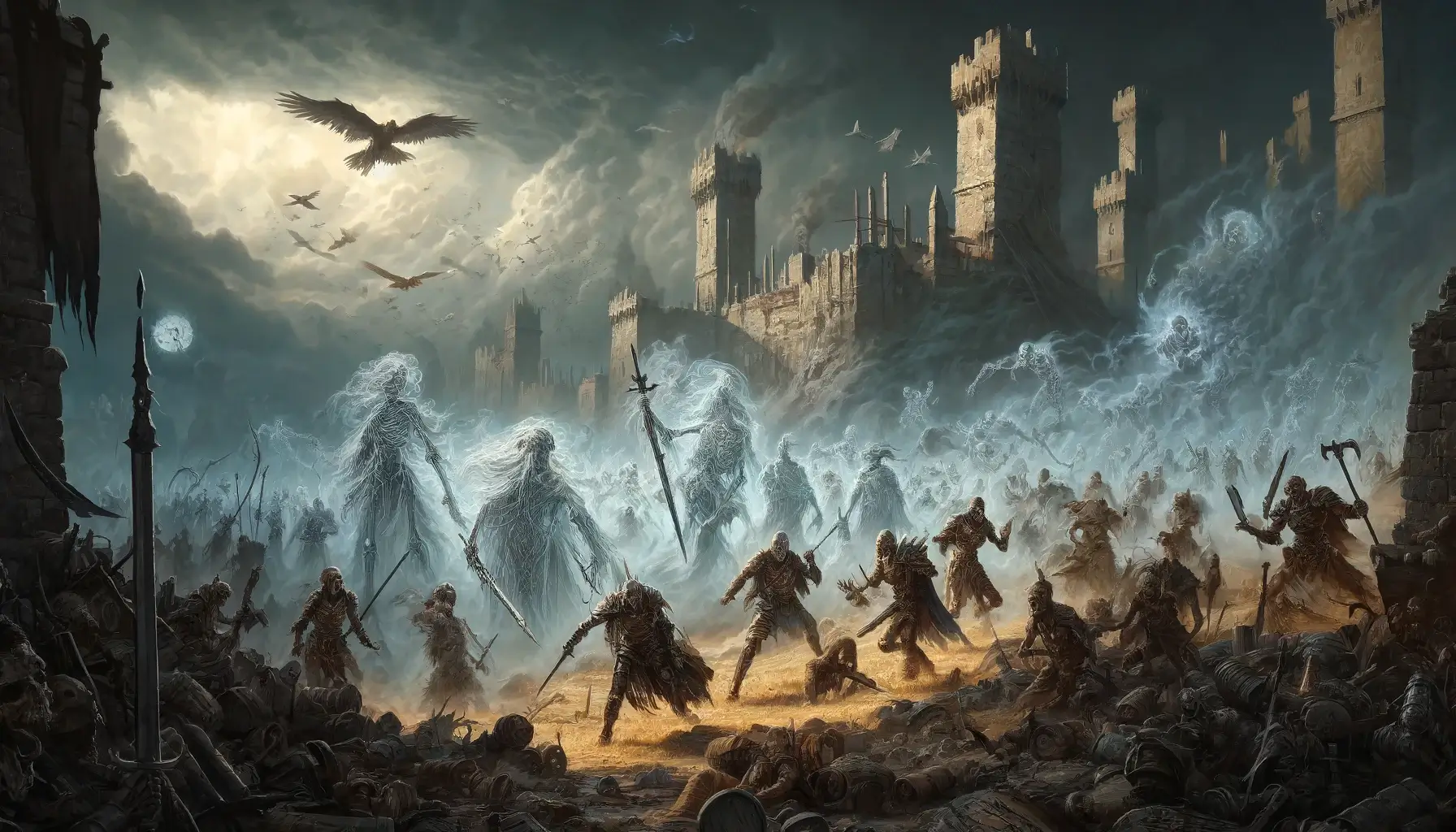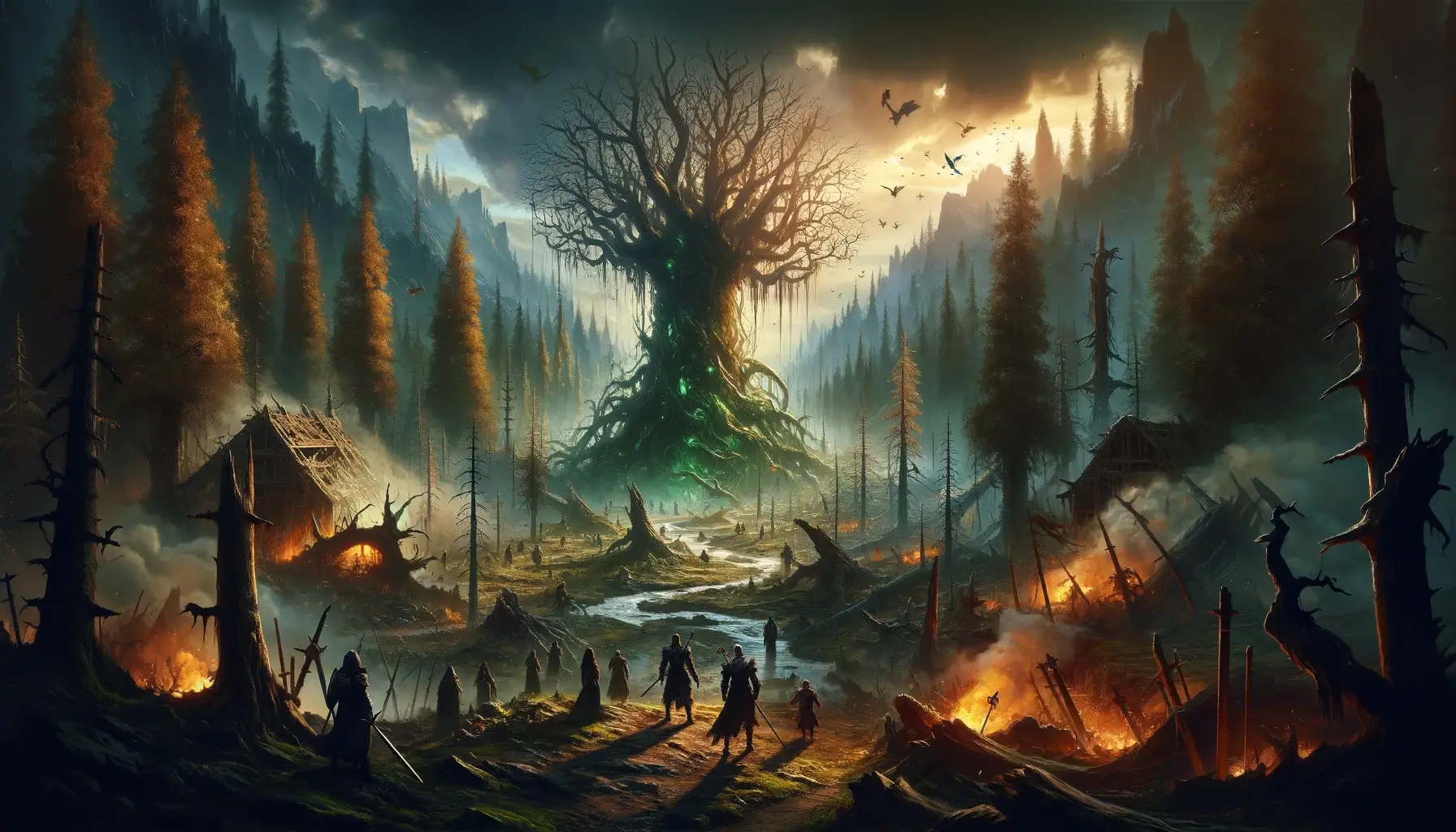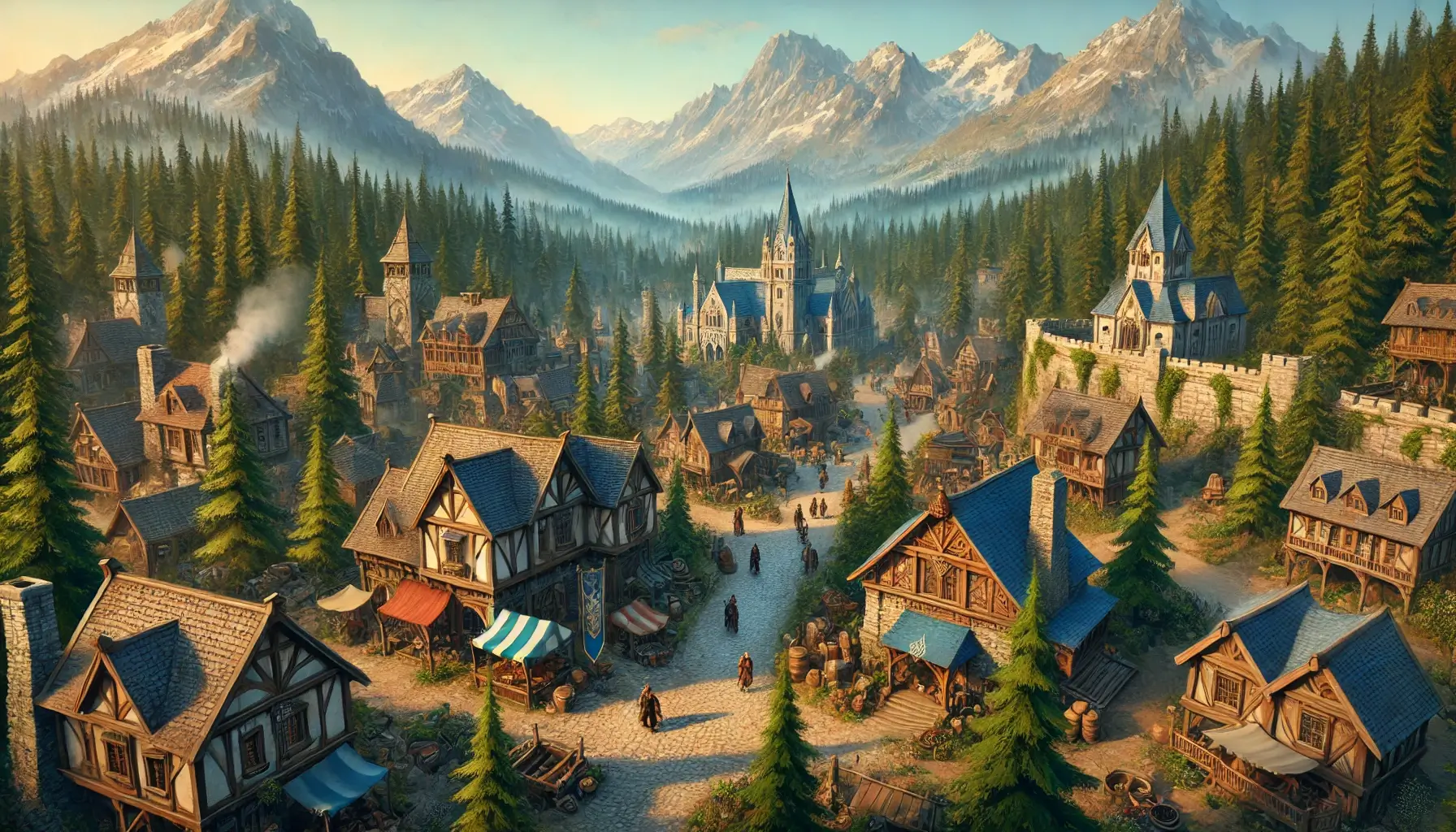The desolate remnants of battlefields hold a chilling appeal for storytellers. These specter-ridden landscapes offer Dungeon Masters a unique setting filled with tragic echoes and the potential for terrifying encounters. But how do you weave together the tangible horrors of war with the intangible dread of the supernatural?
Here’s a guide to incorporating haunted battlegrounds into your campaign, complete with tips, DM notes, and a chilling example.
Unveiling the Past: Setting the Scene
The Battle’s Legacy: What kind of battle took place? Was it a recent skirmish or the final stand of an ancient empire? The age, scale, and nature of the conflict will shape the lingering horrors.
Recent Skirmish: A desperate ambush leaves fields littered with corpses. The cries of the ambushed caravan echo in the minds of those who stumble upon the scene. Perhaps the goods they carried were more valuable than first assumed, and dark forces seek to reclaim them.

“The Three-Day Standoff”
- Scale: A small merchant caravan versus a large bandit group.
- Nature: Bloody ambush, focused on seizing goods. Survivors were executed.
- Lingering Horrors: Wraiths of the caravan guards (stat blocks: shadows, specters) still patrol the ambush site, attacking any armed groups, mistaking them for bandits. Unseen, the bandit leader’s ghost observes, filled with avarice and paranoia.
- DCs: Perception DC 15 to notice the uneven ground where bodies were hastily buried. Investigation DC 13 to recognize the slain belong to a specific caravan company known for rare goods.
- Plot Hook: The caravan transported a disguised relic mistaken for mundane trade goods. Its lingering aura is now attracting the greedy attention of necromancers or other dark forces.
Ancient Stand: Centuries-old armor and rusted weapons are half-buried on a windswept plain. This site was once a mighty fortress, razed in a cataclysmic siege. Unseen spirits replay the final moments of defiance on an eternal loop, and the psychic echoes manifest as eerie sounds or ghostly apparitions.

“Echoes of the Siege of Blackrock”
- Scale: Grand battle – defending kingdom against invading horde.
- Nature: Prolonged siege, fall of a fortress city. Civilians were caught in the crossfire.
- Lingering Horrors: Phantom soldiers on both sides replay the final assault (stat blocks: skeletons, zombies, wraiths). City ruins resonate with the cries of dying civilians. Aggressive poltergeist activity – rocks thrown, spectral figures of grieving women.
- DCs: History DC 12 to recall details of the historic siege. Arcana DC 15 to sense the unnatural resonance of death.
- Plot Hook: Legendary artifact, the “Crown of Kings,” was believed hidden within the city before it fell. The spectral attackers impede any attempt to search the ruins thoroughly.
Hidden Details:
- The Ghost in the Walls: Not all spirits are bound to the battleground. “The White Lady,” the spectral figure of a woman in a tattered noble dress, haunts the inner keep. She was murdered by her own people to prevent her surrender to the enemy. She guides those she deems worthy toward a hidden vault beneath the keep.
- Whispers of Treason: Among the cacophony of battle, spectral whispers speak of a traitor within the city. This spirit might be the murdered White Lady seeking aid, or a manipulative specter trying to sow discord and confusion.
- Buried Truth: The “Crown of Kings” isn’t a singular relic, but a set of enchanted stones cleverly hidden in plain sight amongst the fortress walls. Identifying these stones with careful investigation (DC 17) and a touch of the right magic can reveal their purpose.
Plot Twists:
- Not What It Seems: The defenders were not as heroic as legends portray. Their king was cruel, and some within the city began collaborating with the invaders in hopes of a better ruler. This complicates the moral stance against the spectral attackers.
- The Crown’s True Power: The artifact doesn’t grant dominion, but the spectral echoes of the city’s inhabitants can be harnessed. When worn, the Crown allows communication with ghosts, and with enough skill (Arcana DC 20 + charisma), temporary control over them. This power is tempting for both good and evil purposes.
- The Other Side: While the city is under psychic siege, the invaders’ camp is not immune. Spectral remnants of THEIR fallen might be seeking revenge or could be manipulated by the party as a desperate means of restoring balance.
Escalation of Threat:
- Stage 1: Phantom Defense Characters face relentless waves of spectral soldiers, making exploration difficult and dangerous. The ruins give the spirits a tactical advantage.
Duration: From the moment the party enters the battlefield. Manifestations:
- Phantom soldiers and siege weapons replaying their final moments on a loop.
- Illusions of charging armies or the city under fire create a constant sense of paranoia.
- Minor poltergeist activity like stones thrown or spectral equipment materializing for brief moments.
Focus: Atmosphere and disorientation Hazard Level: Low to medium, depending on party level. Attacks are primarily visual intimidation, though stray projectiles or area-of-effect phantom charges can cause damage.
- Stage 2: Uncovering Secrets: As the party investigates, more nuanced encounters occur. The White Lady might lead them to clues, spectral whispers fuel distrust, and the psychic echoes coalesce into more powerful entities (Will-o-Wisps, Phantom Warrior).
Duration: As players begin investigation and interact with the ruins. Manifestations:
- More targeted spectral forms: The White Lady, whispering voices leading the party deeper, reenactments of betrayal (tied to the hidden plot twist).
- Hauntings focused on hindering progress: spectral hands snatching tools, illusions obscuring paths, etc.
Focus: Mystery and choice. Players may begin to see the spirits aren’t just a mindless threat. Hazard Level: Medium. Some spectral apparitions might have direct attacks out of resentment and confusion.
- Stage 3: Siege Mentality The longer the party remains, the more volatile the psychic atmosphere becomes. Rocks rain down, phantom siege engines materialize, and even the living animals near the ruins are corrupted with unnatural aggression.
Duration: This stage escalates over the course of several sessions in the ruins. Manifestations:
- The atmosphere becomes palpably oppressive. Plant life withers, fog lingers, and animals start fleeing the area or become abnormally aggressive.
- Coordinated phantom attacks: Archers firing volleys, spectral cavalry charging while avoiding obstacles the party can’t see.
- Escalation of poltergeist activity: Siege engines hurl rocks at dangerous speeds, collapsing floors or walls.
Focus: Desperation and increasing danger Hazard Level: High. This stage can cause significant attrition, forcing tactical retreat if the source isn’t addressed.
- Stage 4: The Crown’s Power: If the artifact falls into the wrong hands, a powerful new spectral leader arises – a former city leader corrupted by bitterness and the desire for vengeance, or the invading general filled with an unnatural thirst for conquest.
Duration: When the relic is discovered OR if it falls into the wrong hands (NPCs, rivals, or even a desperate party member). Manifestations:
- Emergence of a spectral leader, imbued with greater power and malevolent will. They direct the psychic forces.
- Phantom armies materialize, acting in strategic cohesion instead of fragmented loops.
- Psychic assaults: The battlefield itself rebels against the party with crushing spectral hands, illusionary pitfalls, etc.
Focus: Climax and consequences Hazard Level: Very High. This becomes a battle rather than exploration, with the potential for total party wipe if mismanaged.
Resolution? The Siege of Blackrock has no easy solutions. Possibilities include:
- Restoring Balance: Putting the tormented spirits of BOTH sides to rest, potentially requiring an act of understanding or atonement.
- Reclaiming the Crown: Wresting the artifact from a corrupted spirit and using it to dispel the haunting, or destroying it entirely.
- Survival: Recognizing the battleground is too dangerous and leading surviving civilians or valuable relics to safety.
Additional Notes on Customization
- Pacing: Adjust the time spent in each stage based on your party’s progress and your desired campaign tone. A fast-paced hack-and-slash campaign might fly through the early stages, while an intrigue-heavy game might spend extended time at Stage 2.
- Clues: Scatter clues about the Crown and the means to put the spirits to rest throughout, giving even a combat-focused group a way to resolve the situation peacefully.
- Allies: Consider potential “safe zones” within the ruins, protected by a benevolent spirit, or even contact with the spectral remnants of the invaders as a bargaining chip.
- Tailor spectral encounters to your party’s level. Simple skeletons and zombies make for hordes, while a lone wraith or revenant can be a terrifying boss-like encounter.
- Use environmental hazards! Crumbling walls, phantom snares hidden in the rubble, and eerie illusions can all play into the haunted battlefield atmosphere.
- Consider a ticking clock – the invaders’ descendants might be returning to reclaim their “ancestral” land.
Clash of Ideologies: A sacred grove is the site of a brutal struggle between pious defenders and a heretical cult. The spiritual residue is tainted by zealotry and dark whispers, where spirits of the slain still clash in an unseen struggle over the site’s corrupting power.

“The Zealot’s Grove”
- Scale: Moderate – a holy order versus a ‘demon’-worshipping cult.
- Nature: Bloody struggle over a sacred site, fueled by fanaticism on both sides.
- Lingering Horrors: Spectral zealots (stat blocks: Revenant, Deathlock Wight) locked in eternal combat. The ground crackles with unnatural energy, twisting plants and attracting predatory creatures empowered by either holy or unholy forces.
- DCs: Religion DC 14 to recognize symbols associated with the holy order. Arcana DC 18 to sense the true nature of the corrupting energy (divine vs. demonic).
- Plot Hook: The site itself is the prize. Each side believes controlling it grants power. Characters might become involved due to their own faith, visions sent by the deities in question, or simply a desire to restore balance to the tainted land.
Spiritual Residue: Consider the emotions that permeated the battlefield. Intense fear, anguish, and rage leave a powerful psychic imprint that attracts spectral entities and fuels unrestful spirits.
Fear and Despair: A battlefield where a massacre occurred leaves an imprint of terror. The cries of the dying create dissonant whispers that plague the living. Shadows might shift to resemble fallen soldiers, or bloodstains on the ground might begin to weep afresh.
- Whispering voices on the wind, phantom figures kneeling in supplication, bloodstains reappearing. Illusions of past horrors play out.
Rage and Vengeance: A battle fueled by hatred leaves seething residues of anger. Wraiths of fallen soldiers continue to attack each other or seek to harm the living out of a misplaced sense of vengeance. The land itself might become corrupted, with plants twisting into thorny shapes and predators gaining unnatural ferocity.
- Aggressive specters, the land twisted with thorny, dead vegetation, predatory animals more feral. Attacks might be focused or indiscriminate.
Bitterness and Betrayal: Conflicts marked by treachery leave behind psychic scars of anguish. Lost souls might wail in regret, reenact the moment of betrayal, or project their self-loathing onto the living, lashing out with maddened sorrow.
- Wailing apparitions, maddening whispers that play on guilt and doubt. The environment feels oppressive, potentially causing characters to turn on each other.
Unearthed Secrets: Battles often reveal hidden things – buried treasure, forgotten sanctuaries, or even dormant portals to otherworldly planes. These unearthed secrets can become a focal point for supernatural activity.
The Hoard under the Hill: A pivotal hill in a large battle is discovered to have been a vast burial mound. The treasure buried with an ancient chieftain now exudes an aura that stirs the dead and attracts malevolent scavengers.
- Possible Encounter: Graverobbers have already disturbed the mound, unleashing guardians (statblocks: mummies, wights). Unknown to them, the true power lies deeper.
- DCs: Perception DC 13 to spot hastily disturbed earth. Investigation DC 16 to determine the grave predates the battle.
The Sanctuary Desecrated: An old battlefield was built upon a forgotten temple dedicated to a peaceful deity. The bloodshed desecrated its power, twisting it into a conduit for those spirits seeking revenge or twisting the site into a shadowy mockery of itself.
- Possible Encounter: An opportunistic cult has repurposed the ruins as their base, drawn to the corrupted energy.
- DCs: Religion DC 12 to recognize the desecrated iconography. Arcana DC 18 to feel the corrupted power (shadowy vs. fiendish taint).
Breached Gateway: The intensity of a magical battle unknowingly weakened the planar barriers. Demons, fey creatures, or otherworldly entities bleed through this fissure, drawn by the psychic energies of the battlefield.
- Possible Encounter: Minor demons or fey creatures slipping through, initially drawn to the psychic energy, now becoming territorial over the battlefield.
- DCs: Arcana DC 15 to sense the thin planar veil. Nature DC 14 to notice the recent change in animal/plant behavior as the otherworldly influence grows.
Tips & Tricks for Atmosphere and Encounters
- Sensory Assault: Describe the lingering stench of death, the eerie whistle of wind through broken banners, and and the unsettling silence punctuated by ravens cawing.
- Smell: The cloying scent of blood, rotting flesh, or if near a swamp, the stench of stagnant water and decaying vegetation.
- Sight: Lingering fog, vultures circling overhead, skeletal figures half-submerged in muddy ground, or discarded remnants of battle (broken swords, tattered banners).
- Sound: Moans carried on the wind, the rasping caw of crows, the distant echo of clashing steel or desperate cries, the disconcerting silence that feels too heavy.
- Spectral Encounters: Avoid predictable ghost tropes. Soldiers might relive their final moments on a loop, a spectral commander barks orders at unseen troops, or the wailing of the wounded transforms into banshee-like apparitions.
- The Eternal Charge: A phantom cavalry charges through the players, only to vanish at the last moment. These echoes may be harmless but disorienting, OR they might drag those caught in their path into the Shadowfell.
- The Ghostly Medic A mournful figure appears, seemingly seeking to aid the wounded. This spirit might be bound to its last act of compassion, or it could be malevolent, draining life from the living to extend its own tortured existence.
- Commanders of the Dead: A spectral general commands an unseen army, reviewing troops, or issuing battle orders. It could be oblivious to the living, or may see the party as new recruits, trapping them in the eternal war.
- Environmental Hazards: The battlefield itself becomes dangerous. Illusions of charging cavalry could lure players into treacherous terrain, or the ground could erupt with skeletal hands seeking to drag victims down.
- The Weight of History: Players’ actions can have repercussions on the spiritual landscape. Putting tormented spirits to rest might calm a region, while desecrating a makeshift grave could unleash vengeful wrath.
DM Notes:
- The Battle’s Legacy
- Recent Skirmish: Emphasize the rawness of the scene. Bodies might still be fresh, attracting scavengers and opportunists. Lingering emotions are potent and disorganized. Focus on the immediate aftermath and the horror of everyday people caught in conflict.
- Ancient Stand: The psychic residue is more organized, replaying key moments of the battle. The environment itself holds clues. Local lore/legends might be exaggerated, but a kernel of truth usually remains. Consider what kind of society existed here before its end.
- Clash of Ideologies: The battlefield is spiritually tainted. Religious symbols, desecrated items, and the unnatural behavior of wildlife underscore this. Survivors might bear scars, both physical and mental, fueling fear and fanaticism.
- Spiritual Residue
- Choose Your Flavor: Decide on the dominant lingering emotion (fear, rage, bitterness). Tailor your descriptions, spectral manifestations, and the behavior of the environment to this core psychic imprint.
- The Ripple Effect: The battlefield’s influence seeps into the surrounding area. Small towns might grow fearful and superstitious, ruins become taboo, trade routes get altered, etc.
- Unearthed Secrets
- Not as it Seems: Battles are perfect for misdirection. The “treasure” might be cursed, the secret sanctuary now houses a malevolent entity, or that planar breach was deliberately created with dark intent.
- Layered Reveals: Scatter clues throughout the battlefield. An unusual symbol on a fallen soldier leads to a hidden map, which hints at the true location of the relic/breach/ritual site.
Tips & Tricks for Atmosphere and Encounters
- Sensory Overload: Go beyond the visual. Use evocative descriptions of smells, sounds, the feel of the air (unnaturally humid, a constant chill, etc.). This grounds the players in the unnaturalness of the place.
- Not Just Ghosts: Tailor spectral encounters based on the lingering emotions. Intense rage might spawn aggressive banshees or poltergeist-like activity, while betrayal could manifest as whispering shadows and deceptive illusions.
- The Environment is a Weapon: The battlefield itself should be a hazard. Churning mud fueled by anguish, phantom snares in crumbled walls, warped plants in corrupted groves – make the setting itself a dynamic challenge.
DM Notes: The Power of the Hidden
Battles have a way of obscuring things. Use the element of the hidden to amplify the mystery and horror of your haunted battleground:
- Titrate the Mystery: Start with subtle hints that something is amiss, then slowly increase the scale and weirdness of the hidden elements. Let players theorize and grow increasingly unsettled before fully revealing the extent of the secret.
- Motivation Matters: Why was the battle hidden? Was it a horrific loss someone tried to erase from history? Is a malevolent entity trying to remain concealed, or a benevolent spirit hoping to avoid attracting attention?
- Moral Ambiguity: Hidden elements on a battlefield force players to question their assumptions. Are they truly liberators, inadvertent pawns, or the next victims in an ongoing conflict?
- Secret Sacrifices: Perhaps the battle was a dark ritual in disguise, its true purpose concealed from even the soldiers who fought in it.
- Ritual Sacrifice: The battlefield was the site of a blood sacrifice, its true purpose masked as a military maneuver. Now, something monstrous stirs beneath the earth, drawing strength from the unknowingly spilled blood.
- Buried Relics: A powerful artifact, its nature unknown to those who fought over it, lies buried and forgotten, fueling the spectral unrest.
- The Cursed Relic An artifact of devastating power was lost during the battle. Perhaps it was shattered, its fragments scattered unknowingly across the field and radiating a malevolent aura.
- Otherworldly Breach: The intensity of the battle tore a thin veil between worlds, allowing malevolent entities to bleed through. This breach might be subtly growing…
- The Growing Rift: The battle tore open a planar rift. Initially small, it widens with each conflict or each display of strong negative emotion on the battlefield, allowing increasingly dangerous entities to slip through.
Epic Example: The Whispering Marsh
- Escalation is Key: Begin with subtle, unsettling hints – the off-kilter behavior of animals, the way the fog seems to cling and writhe. Gradually introduce more direct manifestations of the fey corruption.
- The Feystone is Alive: Treat it almost as a sentient entity. Its pulsations grow stronger as the party gets closer. The marsh’s corruption is an extension of its will, making plant life menacing and amplifying shadow fey powers.
- Beyond Combat: The final encounter shouldn’t just be about destroying the feystone. Introduce a way to cleanse/neutralize its corruption, tying it to the ritual that summoned the fey (perhaps undoing elements of the summoning).
Additional DM Considerations
- Pacing: Start slow with a ‘normal’ encounter, then weave in unsettling details. Let the sense of growing unease guide the pace at which the haunting intensifies.
- Player Agency: Provide choices that matter. Attempting to purify the battlefield, exploiting its power, or simply fleeing with the knowledge of its danger – all are valid responses with far-reaching consequences.
- Campaign Integration: How does this haunted battlefield tie into the larger narrative? Is this a standalone side-quest, the revelation of a wider threat, or a potent location the party might return to with dire necessity?
Intro Boxed Text
- Voiceover: A desolate wind whispers across a forgotten battlefield. Skeletal remains mingle with rusted weapons, the only markers of some past conflict. The air feels heavy, the silence unnatural. Yet, beneath the stillness, something stirs – echoes of the past, bound to this place of violence and sorrow.
- Placement: Use this during the party’s initial approach to the haunted battlefield. It sets the tone of desolation and hints at the lingering supernatural presence.
Boxed Text: As they Explore
- Voiceover: A ragged scrap of cloth, once a proud banner, flutters in the breeze. As you pass, a spectral voice whispers a name… a lament… a plea. The spectral echoes seem to coalesce around you, the air growing colder.
- Placement: As the players begin exploring, this ramps up the atmosphere. They now know the battlefield is haunted, and there’s an element of mystery (who is speaking, why, etc.).
Boxed Text: Unearthing the Past
- Voiceover: Beneath a mound of earth, you uncover a tarnished locket. As your fingers brush against it, a phantom figure shimmers into existence – a woman weeping, her ephemeral form bound to this object of memory. The whispers around you turn accusatory, questioning…
- Placement: When players find something tied to the hidden details of the battle (the White Lady’s locket, a map hinting at the buried relic). This ramps up the mystery and interaction with the spectral entities.
Boxed Text: Escalation
- Voiceover: The very ground beneath your feet buckles as skeletal hands claw upwards, weathered armor rattling. You’re no longer observers, but targets. The spirits of this desolate place have awakened and seek to drag you into their eternal conflict.
- Placement: This triggers a more significant combat encounter as the psychic tension of the battlefield reaches a breaking point. The players must now deal with the direct, hostile manifestation of the spectral forces.
Tips for Using Boxed Text
- Pacing: Don’t overuse boxed text. Intersperse it with regular exploration and role-playing.
- Tailor It: Change the sensory details of the boxed text to match your setting (the clinging mist of a marsh instead of a dry wind, the cries of monstrous things instead of human voices).
- Player Narration: For pivotal moments, let a player read a boxed text segment! This intensifies immersion.
Extra DM Notes: Integrating the Boxed Text
Here’s how the boxed text aligns with the escalation of your scenario and ties into the DM Notes you’ve been given:
- Intro: Sets the atmospheric tone and introduces the haunting.
- Exploration: Hints at the hidden story, building mystery (“the plea” in the text) and making the spirits tangible.
- Unearthing: Connects a tangible object to the spectral forces, and might be a clue (the White Lady’s locket).
- Escalation: The party’s actions have stirred the battlefield to direct hostility, a shift from the spectral residue to active combat.





























